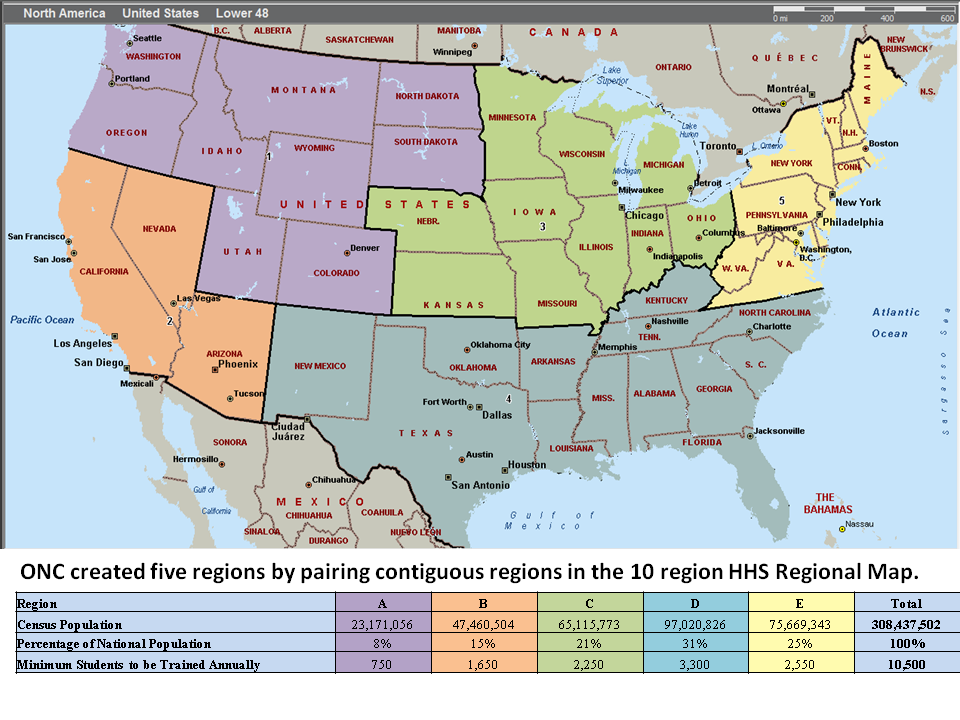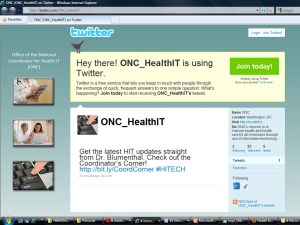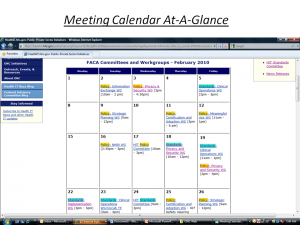Three Categories of Twelve Health IT Priority Workforce Roles Defined: Training Funded by ONC
Office of the National Coordinator (ONC) for Health IT has defined 12 key roles necessary to support the rollout of Electronic Health Records (EHRs) and Health Information Exchange (HIE) as part of the HITECH initiative. ONC funding announced on April 12, 2010, supports education and training divided between five consortia of community colleges for six of the roles, and nine universities for the other six roles. This e-Healthcare Marketing post has selected excerpts from the original ONC Funding Announcements with descriptions of the roles.
“A total of 12 workforce roles are described below, spanning the full range of roles envisioned in ONC’s workforce program. These roles are described in three general categories.
“Competencies associated with six of the roles listed below can, for qualified individuals, be attained through six month programs based in community colleges. These roles (noted with an asterisk, below) are specifically targeted by the Community College Consortia to Educate Health Information Technology Professionals FOA (Funding Opportunity (FOA) . The other six roles listed below, that are not marked with an asterisk are addressed by” the FOA entitled Information Technology Professionals in Health Care: Program of Assistance for University-Based Training
Outline of Twelve Roles in Three Categories
Category 1: Mobile Adoption Support Roles
“These members of the workforce will support implementation at specific locations, for a period of time, and when their work is done, will move on to new locations. They might be employed by regional extension centers, vendors, or state/city public health agencies.
*Implementation support specialist
*Practice workflow and information management redesign specialist
*Clinician consultant
*Implementation manager”
Category 2: Permanent Staff of Health Care Delivery and Public Health Sites
“These roles are needed for ongoing support of health IT at office practices, hospitals, health centers, Long Term Care (LTC) facilities, health information exchange organizations and state and local public health agencies.
Clinician/public health leader
*Technical/software support staff
*Trainer
Health information management and exchange specialist
Health information privacy and security specialist”
Category 3: Health Care and Public Health Informaticians
“These individuals will be based in universities, research centers, government agencies, and research and development divisions of software companies.
Research and development scientist
Programmers and software engineer
Health IT sub-specialist”
* Asterisked roles above are focus of Community college training.
Detail of the Twelve Health IT Professional Roles
Category 1: Mobile Adoption Support Positions
“These members of the workforce will support implementation at specific locations for a period of time, and when their work is done, will move on to new locations. Workers in these roles might be employed by regional extension centers, providers, vendors, or state/city public health agencies, and would work together in teams. Preparation for this set of roles will typically require six months of intense training for individuals with appropriate backgrounds.”
1. Practice workflow and information management redesign specialists: (Community college-trained)
“Workers in this role assist in reorganizing the work of a provider to take full advantage of the features of health IT in pursuit of meaningful use of health IT to improve health and care. Individuals in this role may have backgrounds in health care (for example, as a practice administrator) or in information technology, but are not licensed clinical professionals. Workers in this role will:
- Conduct user requirements analysis to facilitate workflow design
- Integrate information technology functions into workflow
- Document health information exchange needs
- Design processes and information flows that accommodate quality improvement and reporting
- Work with provider personnel to implement revised workflows
- Evaluate process workflows to validate or improve practice’s systems”
2. Clinician/practitioner consultants: (Community college-trained)
“This role is similar to the “redesign specialist” role listed above but brings to bear the background and experience of a licensed clinical and professional or public health professional. In addition to the activities noted above, workers in this role will:
- Suggest solutions for health IT implementation problems in clinical and public health settings
- Address workflow and data collection issues from a clinical perspective, including quality measurement and improvement
- Assist in selection of vendors and software
- Advocate for users’ needs, acting as a liaison between users, IT staff, and vendors”
3. Implementation support specialists: (Community college-trained)
“Workers in this role provide on-site user support for the period of time before and during implementation of health IT systems in clinical and public health settings. The previous background of workers in this role includes information technology or information management. Workers in this role will:
- Execute implementation project plans, by installing hardware (as needed) and configuring software to meet practice needs
- Incorporate usability principles into design and implementation
- Test the software against performance specifications
- Interact with the vendors as needed to rectify problems that occur during the deployment process”
4. Implementation managers: (Community college-trained)
“Workers in this role provide on-site management of mobile adoption support teams for the period of time before and during implementation of health IT systems in clinical and public health settings. Workers in this role will, prior to training, have experience in health and/or IT environments as well as administrative and managerial experience. Workers in this role will:
- Apply project management and change management principles to create implementation project plans to achieve the project goals
- Interact with office/hospital personnel to ensure open communication with the support team
- Lead implementation teams consisting of workers in the roles described above
- Manage vendor relations, providing feedback to health IT vendors for product improvement”
Category 2: Permanent Staff of Health Care Delivery and Public Health Sites
“These roles are needed for ongoing support of health IT that has been deployed in office practices, hospitals, health centers, long-term care facilities, health information exchange organizations and state and local public health agencies. Preparation for this set of roles will typically require six months of intense training for individuals with appropriate backgrounds.”
5. Clinician/Public Health Leader: (University-trained)
“By combining formal clinical or public health training with training in health IT, individuals in this role will be able to lead the successful deployment and use of health IT to achieve transformational improvement in the quality, safety, outcomes, and thus in the value, of health services in the United States. In the health care provider settings, this role may be currently expressed through job titles such as Chief Medical Information Officer (CMIO), Chief Nursing Informatics Officer (CNIO). In public health agencies, this role may be currently expressed through job titles such as Chief Information or Chief Informatics Officer. Training appropriate to this role will require at least one year of study leading to a university-issued certificate or master’s degree in health informatics or health IT, as a complement to the individual’s prior clinical or public health academic training. For this role, the entering trainees may be physicians (see footnote below for definition of physician used) or other clinical professionals (e.g. advanced-practice nurses, physician assistants) or hold a master’s or doctoral degree(s) in public health or related health field. Individuals could also enter this training while enrolled in programs leading directly to degrees qualifying them to practice as physicians or other clinical professionals, or to master’s or doctoral degrees in public health or related fields (such as epidemiology). Thus, individuals could be supported for training if they already hold or if they are currently enrolled in courses of study leading to physician, other clinical professional, or public-health professional degrees.”
6. Technical/software support staff: (Community college-trained)
“Workers in this role maintain systems in clinical and public health settings, including patching and upgrading of software. The previous background of workers in this role includes information technology or information management. Workers in this role will:
- Interact with end users to diagnose IT problems and implement solutions
- Document IT problems and evaluate the effectiveness of problem resolution
- Support systems security and standards”
7. Trainers: (Community college-trained)
“Workers in this role design and deliver training programs, using adult learning principles, to employees in clinical and public health settings. The previous background of workers in this role includes experience as a health professional or health information management specialist. Experience as a trainer in from the classroom is also desired. Workers in this role will:
- Be able to use a range of health IT applications, preferably at an expert level
- Communicate both health and IT concepts as appropriate
- Assess training needs and competencies of learners
- Design lesson plans, structuring active learning experiences for users
Track training records of the users and develop learning plans for further instruction”
8. Health Information Management and Exchange Specialist: (University-trained)
“Individuals in these roles support the collection, management, retrieval, exchange, and/or analysis of information in electronic form, in health care and public health organizations. We anticipate that graduates of this training would typically not enter directly into leadership or management roles. We would expect that training appropriate to this role would require specialization within baccalaureate-level studies or a certificate of advanced studies or post-baccalaureate-level training in Health Information Management, health informatics, or related fields, leading to a university-issued certificate or master’s degree.”
9. Health Information Privacy and Security Specialist: (University-trained)
“Maintaining trust by ensuring the privacy and security of health information is an essential component of any successful health IT deployment. Individuals in this role would be qualified to serve as institutional/organizational information privacy or security officers. We anticipate that training appropriate to this role would require specialization within baccalaureate-level studies or a certificate of advanced studies or post-baccalaureate-level training in health information management, health informatics, or related fields, leading to a university-issued certificate or master’s degree.”
Category 3: Health Care and Public Health Informaticians
“These individuals will be based in universities, research centers, government agencies, and research and development divisions of software companies.”
10. Research and Development Scientist: (University-trained)
“These individuals will support efforts to create innovative models and solutions that advance the capabilities of health IT, and conduct studies on the effectiveness of health IT and its effect on health care quality. Individuals trained for these positions would also be expected to take positions as teachers in institutions of higher education including community colleges, building health IT training capacity across the nation. We anticipate that training appropriate to this role will require a doctoral degree in informatics or related fields for individuals not holding an advanced degree in one of the health professions, or a master’s degree for physicians or other individuals holding a doctoral degree in any health professions for which a doctoral degree is the minimum degree required to enter professional practice.”
11. Programmers and Software Engineer: (University-trained)
“We anticipate that these individuals will be the architects and developers of advanced health IT solutions. These individuals will be cross-trained in IT and health domains, thereby possessing a high level of familiarity with health domains to complement their technical skills in computer and information science. As such, the solutions they develop would be expected to reflect a sophisticated understanding of the problems being addressed and the special problems created by the culture, organizational context, and workflow of health care. We would expect that training appropriate to this role would generally require specialization within baccalaureate-level studies or a certificate of advanced studies or post-baccalaureate-level training in health informatics or related field, but a university-issued certificate of advanced training in a health-related topic area would as also seem appropriate for individuals with IT backgrounds.”
12. Health IT Sub-specialist: (University-trained)
“The ultimate success of health IT will require, as part of the workforce, a relatively small number of individuals whose training combines health care or public health generalist knowledge, knowledge of IT, and deep knowledge drawn from disciplines that inform health IT policy or technology. Such disciplines include ethics, economics, business, policy and planning, cognitive psychology, and industrial/systems engineering. The deep understanding of an external discipline, as it applies to health IT, will enable these individuals to complement the work of the research and development scientists described above. These individuals would be expected to find employment in research and development settings, and could serve important roles as teachers. We would expect that training appropriate to this type of role would require successful completion of at least a master’s degree in an appropriate discipline other than health informatics, but with a course of study that closely aligns with health IT. We would further expect that such individuals’ original research (e.g. master’s thesis) work would be on a topic directly related to health IT.”
Definition of Physician: For purposes of the University-based training programs, ”the term “physician” is defined as an individual holding one or more of the following degrees: doctor of medicine or osteopathy, doctor of medical dentistry, doctor of optometry, doctor of podiatric medicine, doctor of chiropractic. This definition is consistent with the definition of a physician in the Medicare program (Section 1861(r) of the Social Security Act (42 U.S.C. 1395w—4), which is the established by SSA Section 1848(o), as added by the Recovery Act, as the definition of professionals eligible for the Medicare incentives for meaningful use of certified EHR technology authorized by the HITECH Act.”
For more about Community College Consortia Programs and map of regional areas, see this post on e-Heathcare Marketing.
For more about University-Based Training Programs, see this post on e-Heathcare Marketing.



